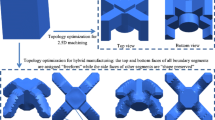Abstract
Today, characteristic-based quality analysis has been popular in academia and industry with its ability to show the error evolution of parts during manufacturing. To date, research on characteristics mainly focuses on characteristic sequence, characteristic extraction, characteristic deflection, and characteristic identification, which are all for individual characteristics. However, a key characteristic is not only influenced by each machining itself but also by further machining linked-characteristics. This paper analyzes manufacturing characteristic interactions and presents algorithms, simulation, and experiment for linked characteristic interactions in manufacturing process planning. Firstly, a geometric model shows the tolerance/datum interactions. Secondly, thin-walled parts of aluminum alloy are used to analyze and simulate the machining interactions based on ANSYS system. By analyzing the simulation and experiment results, discussion and evaluation of the results and conclusions are submitted.
Similar content being viewed by others
References
Chen W, Xue J, Tang D, Chen H, Qu S (2009) Deformation prediction and error compensation in multilayer milling processes for thin-walled parts. Int J Mach Tools Manuf 49(11):859–864
Liao YG, Hu SJ (2001) An integrated model of a fixture–workpiece system for surface quality prediction. Int J Adv Manuf Technol 17:810–818
Qin G, Zhang W, Wu Z, Wan M (2007) Systematic modeling of workpiece-fixture geometric default and compliance for the prediction of workpiece machining error. J Manuf Sci Eng 129:789–801
Liu S, Zheng L, Zhang Z, Li Z, Liu D (2007) Optimization of the number and positions of fixture locators in the peripheral milling of a low-rigidity workpiece. Int J Adv Manuf Technol 33:668–676
Wang MY (2003) Contact force prediction and force closure analysis of a fixtured rigid workpiece with friction. J Manuf Sci Eng 125:325–332
Wan XJ, Xiong CH, Wang XF, Zhang XM, Xiong YL (2010) A machining-feature-driven approach to locating scheme in multi-axis milling. Int J Mach Tools Manuf 50:42–50
Heo E-Y, Kim DW, Lee JY, Lee CS, Chen FF (2011) High speed pocket milling planning by feature-based machining area partitioning. Robot Comput Integr Manuf 27:706–713
Hayes C (1990) Machining planning: a model of an expert level planning process, Ph.D. Dissertation, Carnegie Mellon University, USA
Sormaz D (2000) Modeling of manufacturing feature interactions for automated process planning. J Manuf Syst 19:28–45
Chen CLP, Le Clair SR (1994) Integration of design and manufacturing: solving setup generation and feature sequencing using an unsupervised learning approach. Comput Aided Des 26:59–75
Dipper T, Xu X, Klemm P (2011) Defining, recognizing and representing feature interactions in a feature-based data model. Robot Comput Integr Manuf 27(1):101–114
Deja M, Siemiatkowski MS (2013) Feature-based generation of machining process plans for optimised parts manufacture. J Intell Manuf 24:831–846
Sunil VB, Pande SS (2009) Automatic recognition of machining features using artificial neural networks. Int J Adv Manuf Technol 41:932–947
Hart AJ, Slocum A, Willoughby P (2004) Kinematic coupling interchangeability. Precis Eng 28:1–15
Huang Q, Shi J, Yuan J (2003) Part dimensional error and its propagation modeling in multi-operational machining processes. J Manuf Sci Eng 125(2):255–262
Ding Y, Ceglarek D, Shi J (2002) Fault diagnosis of multistage manufacturing processes by using state space approach. J Manuf Sci Eng 124(2):313–322
Camelio JA, Hu SJ, Marin S (2004) Compliant assembly variation analysis using components geometric covariance. J Manuf Sci Eng 126(2):355–360
Liu Z, Wang L (2007) Sequencing of interacting prismatic machining features for process planning. Comput Ind 58:295–303
Bravo U, Altuzarra O, Lo´pez de Lacalle LN, Sa´nchez JA, Campa FJ (2005) Stability limits of milling considering the flexibility of the workpiece and the machine. Int J Mach Tools Manuf 45:1669–1680
Author information
Authors and Affiliations
Corresponding author
Rights and permissions
About this article
Cite this article
Li, B., Zuo, X., Yang, J. et al. Interactive influence of linked characteristics during machining of thin-walled parts. Int J Adv Manuf Technol 72, 1727–1734 (2014). https://doi.org/10.1007/s00170-014-5797-4
Received:
Accepted:
Published:
Issue Date:
DOI: https://doi.org/10.1007/s00170-014-5797-4




